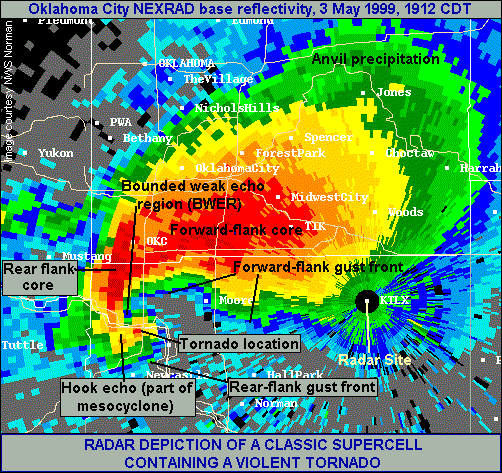Ik ben nieuw hier op het forum.
Ik heb een timelapse gemaakt van de radarbeelden op 25 en 26 mei 2009
Wat mij meteen opviel, was dat de laatste wolkenformatie een krullend effect kreeg toen het het noorden van ons land verliet.
Wat stelt dat precies voor? Een lagedrukgebied zal het niet kunnen zijn denk ik, wat dan wel?
Het gebeurd allemaal tussen de 00:14 - 00:18 seconden.
Waar het mij ook aan doet denken is een typisch amerikaanse supercell, waar dan in het zuid-westelijke deel van de supercell een instroom is van andere luchtdelen, waardoor ook een krul ontstaat.
Hier het filmpje:
een supercell is het niet . en je bedoelde een hook echo die altijd duidelijk te zien is bij de supercell met een goede rotatie.

een supercell is het niet . en je bedoelde een hook echo die altijd duidelijk te zien is bij de supercell met een goede rotatie.
Er werd die dag wel gesproken over een supercell in het zuiden van Belgie
maar met de omstandigheden die er waren was een supercell goed mogelijk maar, de echo van de radar lijkt me daar te vaag voor meestal krijg je dan een regenband met veel neerslag er omheen gewikkeld .
het heeft meer weg van een comma die ontstond maar dat is mijn mening en mischien heb ik het wel helemaal fout

The term bow echo was first used by Dr. Theodore Fujita of the University of Chicago in his 1978 paper “Manual of Downburst Identification for Project NIMROD.â€[1] In 2004, research was done to better anticipate the formation of bow echoes. They studied the formation of bow echoes from weakly organized squall lines, and supercells. They determined that bow echoes were most likely to occur in weakly organized cells.[2] In 2007, from February 28 to March 1, there was a Midwest Bow Echo Workshop, where meteorologists gathered to share their research and finding with each other to better understand bow echoes.[3]
[edit] Formation
A bow echo is associated with squall lines or lines of convective thunderstorms. These echoes can range in size from 20 to 200 km, and have a life span of 3 to 6 hours. Bow echoes tend to develop when moderate to strong wind shear exists in the lower 2 to 3 km of the atmosphere. While similar to squall lines, bow echoes are smaller in scale; and are moved by the wind inside them. They tend to push outward and after time die out. A bow echo also lowers the chance of a tornado being formed in the storm itself. The "bow shaped" echo is a result of focusing of the strong flow at the rear of the system.[4] Especially strong bow echoes that cause devastating damage all along the width of the storm are often called derechos.
[edit] Rear inflow jet
The formation of a bow echo requires a strong elevated rear inflow jet at mid-levels. The strength of the cold pool and mesohigh at the surface as well as warmer temperatures aloft due to convection works to create a mesolow at mid-levels which strengthens the jet. Upon reaching the edge of the convection the jet descends and spreads along the surface, generating straight-line winds.[5]
[edit] Book end vortices
After the rear inflow jet has bowed the storm system, book end or line end vortices develop on either side of the jet. These vortices are similar in strength.[6] Due to the small size of the bow echo, the vortices help enhance the mid-level flow between them. This strengthens the rear inflow jet. The surface winds increase from the descending jet.[7] As the life of the storm increases, the Coriolis force acts to intensify the cyclonic vortex and weaken the anticyclonic vortex. The system then develops an asymmetric comma-shaped echo.[8][9] Some embedded tornadoes or gustnadoes develop within these vortices.

 Timelapse radarbeelden van 25/26 mei
Timelapse radarbeelden van 25/26 mei




